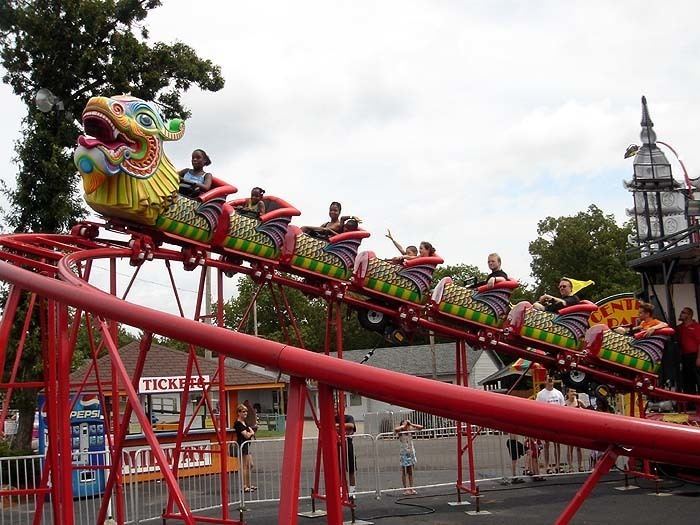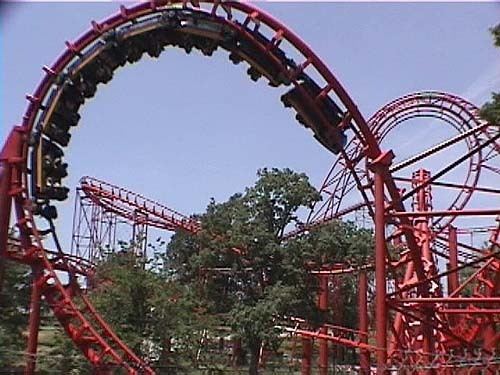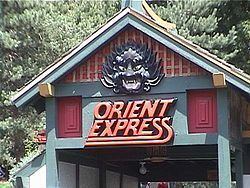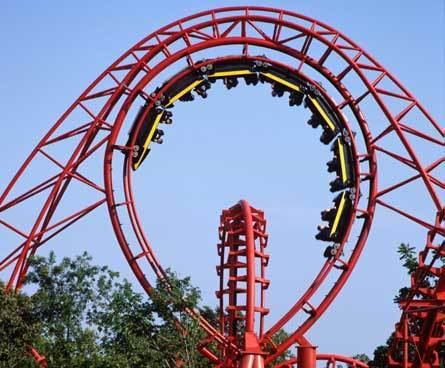Park section Orient Opening date April 4, 1980 Height 36 m Max speed 80 km/h | Status Closed Closing date October 26, 2003 Closed 26 October 2003 Height restriction 1.22 m | |
 | ||
Similar Zambezi Zinger, Mamba, Timber Wolf, Patriot, Spinning Dragons | ||
Orient Express was a steel roller coaster at Worlds of Fun amusement park in Kansas City, Missouri, introduced in 1980. The red-orange track was in between the two entrances of the park. The station house is still visible, and contains the park's haunted attraction Lore of the Vampire and Club Blood.
Contents
The ride

The Orient Express was the first coaster ever to have a "Kamikaze Curve" element, which was later termed a "boomerang" by Arrow Dynamics and a "batwing" by Bolliger & Mabillard. This element consists of a 90-degree rise to the right or left (similar to half a corkscrew), followed by half of a traditional loop element, then a rising half loop, then a final 90-degree dive sending the track in the same direction it entered the element. This element was later often used on Arrow's larger looping coasters, as well as on the Vekoma designed Goudurix at Parc Astérix, where it was known as a "Double Sidewinder", and on B&M's inverted roller coasters. The Orient Express also featured a tunnel prior to the lift hill that housed the Orient Express Dragon, a wooden sign that had the ride's logo illuminated.

The queue house had a "chicken exit" that guests could take if they chickened out at the last minute. The sign for the chicken exit now resides in the station house for Timber Wolf.

The Orient Express was also the second full circuit roller coaster to have interlocking loops, the Loch Ness Monster being the first. Lightnin' Loops at Six Flags Great Adventure, which opened in 1978, was the first roller coaster to have interlocking loops, but the coaster was made up of two separate shuttle tracks. With the retirement of the Orient Express, the Loch Ness Monster is again the only coaster with this feature.
The ride started out running three trains at once but over time only two would run at a time due to the ride's blocking system. If there was a backup in the station it caused a train to stop just outside the station and another train would stop halfway through the ride on the C-Brake. This caused the ride to shut down and the only way to get the train out of the trim brakes halfway through the ride was to have an employee climb up the C-Brake stairs and manually release the brakes.

The Orient Express suffered several malfunctions within the last seasons of its life. It broke down often and in 1999 the last two cars derailed just before the final brake, leaving riders stranded for a couple of hours. Contrary to some rumors, no one ever died on the roller coaster, and it also was never stuck upside-down. The site Orient Express was located on also remains empty, contrary to the belief that Spinning Dragons and Patriot replaced the roller coaster. Behind Spinning Dragons, the ride's old station still remains.
Other information
Number of trains: 3
Number of cars per train: 7
Passengers per car: 4
The ride was broken into 3 blocks. Block A was the station to the top of the lift. Block B was the top of the lift to halfway through the mid-course (C-Brake). Block C was from halfway through the midcourse (C-Brake) to the final brakes at the end of the ride. When running three trains, one would be in the station loading passengers while the second would be climbing the lift and the third was out on the track. As the lift train cleared the lift, the house train was released for the lift. This was a fast paced operation since the car had to enter the house, unload and load all in the span of time it took a train to climb the lift. Shutdowns would happen when the train in the station was not dispatched causing the second train to stop in the final brakes just outside the station, and in chain reaction, causing the third train to stop in the C-Brake. This was mainly caused by riders taking too long to exit or load in the train.
Restart after a shutdown required the assistance of the parks' maintenance staff. One person would go to the manual brake release under the C brake while the other ran the control panel brake in the house. One train would be taken to the top of the lift and stopped. The second train would be stopped at the C brake before the second inverted loop. The third train would be in the house. To start the process, the C brake was pulled to release the train for the second loop. The lift train would be released as soon as the C block train was clear of the brake. Once the lift train cleared the house train was released. This was done several times during the first year of operation until the ride was reduced to two trains.
